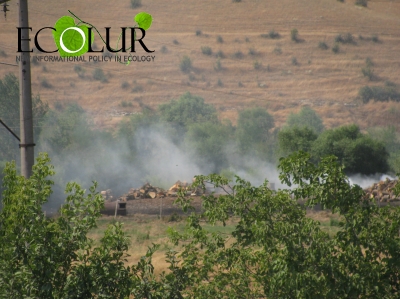

EcoLur
EcoLur launches new series of articles “Forest Stories” based on the visits to pre-forest communities in Armenia, meetings with the residents, heads of local administrations and representatives of “ArmForest” SNCO.
Tavush Region is the main supplier of the timber: “ArmForest” SNCO includes four forest enterprises in Tavush region – Artsvanik, Ijevan, Noyemberyan and Sevqar with a total area of 118,067 ha, out of which 104 857.6 ha is covered with the forest. The working group of experts working in the frames of FLEG 2 visited two villages in Tavush Region, Azatamut and Aknaghbyur, which are near-forest communities in Sevqar forestry enterprise.
Talks with the locals in Azatamut and Aknaghbyur villages showed that the people are practically suspended from forest management. Many of them even don’t know what volume of free-of-charge firewood from fallen deadwood they are entitled to. In reply to Expert Laywer Nazeli Vardanyan’s remark that this volume makes up 8 cubic meters per year, people answered that it didn’t matter, as the fallen deadwood doesn’t have this amount. “Who can walk 5-6 km? No forest nearby, it’s been felled down long ago, while the trees grown instead is not suitable for warming or anything else. Despite this, the need for firewood is high among the villagers. Gas and electricity are costly for the villagers. “Our lives should be improved to conserve the forest…Why to burn fire, if we can heat with gas or prepare food in the electric oven? We have to burn fire.”
We couldn’t specify exactly how much firewood the villagers use per year: different figures were sad from 3 to 15 cubic years per year. Consequently, even a small village, if its uses average amount of firewood, for example, 12 cubic meters, will spend the whole resource of the forestry enterprise. For example, Aknaghbyur Village has around 140 farming households, while Azatamut village has over 900. Azatamut community used to be an urban-type community having formed on the basis of Bentonit plant, which is the reason for small number of agricultural land areas. Currently the plant has practically suspended its activities. Main male population left the village for other countries to earn money, and the women have to carry the entire burden for supporting the family. They don’t have jobs, agrofood is almost not sold in the markets. The men having remained in the village deal with forest felling and production of charcoal. The whole village is covered with smoke. Aknaghbyur village spoke about the opportunities of using non-timber forest products and development of beekeeping, if the problem with product realizations in available economic scales is solved.
In reply to the question what they think about “green” economy, for example, development of rural tourism, collection of forest products Tavush forests are rich in, such as rosehip, raspberry, blackberry etc, they said they want to, but don’t know how to do. Mainly children collect forest berries, while the elderly sell them. In the high season the locals stand along the whole highway with buckets of forest berries. “Getting ready for school… Children need everything: books and clothes…we need money,” people said.
FLEG 2 program will table proposals on developing communities aimed at sustainable and effective forest management.
 |
 |
 |
 |
 |
 |
 |
 |
 |
 |
 |
August 28, 2015 at 13:22
